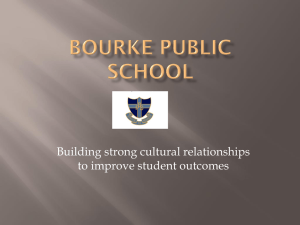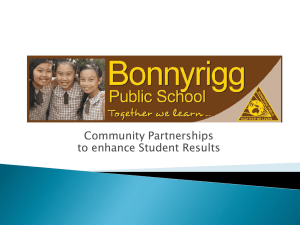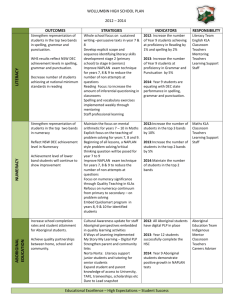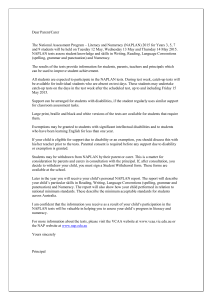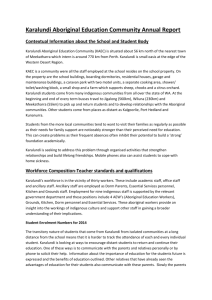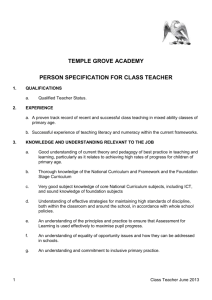2014 Annual School Report
advertisement
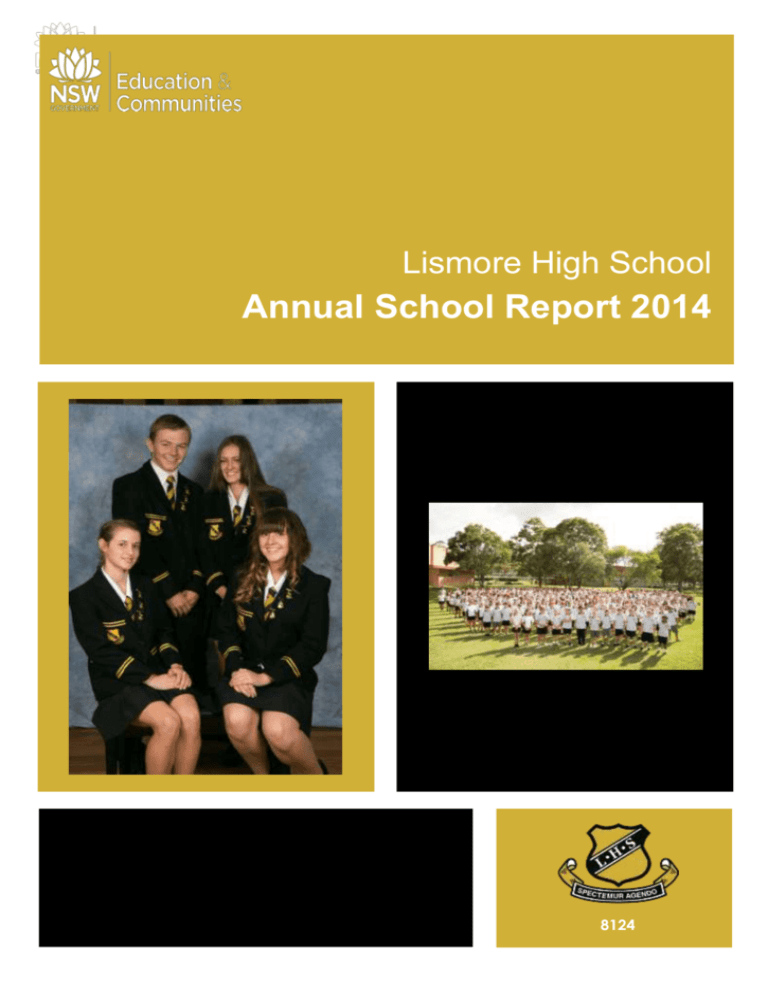
Lismore High School Annual School Report 2014 [school code] 8124 have completed our second batch of elections for our school leaders and prefects for 2015. The time I have spent working with our 2015 leaders inspire me with confidence of positive change within the school. School Context Lismore High School has undergone significant demographic change over the past 10 years. The student clientele has changed from professional families to blue collar and service industry families. It has a significant population of Aboriginal students 20% and 5% Non-English Speaking Background. This has resulted in the recognition that old teaching practices are not relevant to students. The enrolment for 2015 is 360 students. The start of 2015 has seen the largest increase of Year 7 enrolments in many years. I have spent a lot of time meeting with the Department of Education and Communities lawyers and the Perpetual Trust lawyers of the Nesbitt award. The Nesbitt award is a significant donation of funds to Lismore High School students. The award has been in abeyance for over five years due to complications with the trust in delivering on the conditions of the will. The new Nesbitt award which will begin in 2015 has the complications removed and will be focused around academic achievement. In the last two years there have been significant improvements made at the school. School attendance rates are the highest in 5 years, National Assessment Program Literacy and Numeracy growth rates are the highest in 7 years. Higher School Certificate results are the most improved in 10 years. A culture of learning is evident in the school for staff and students, backed by strong student wellbeing programs and teaching and learning backed by data driven improvement. The school has a very strong partnership with Southern Cross University and students have access to University facilities for wider learning. Lismore High School works strongly with the Education faculty S.C.U. in preservice teacher training. Lismore High School is part of the Rivers Secondary College and works collaboratively with Richmond River High School and Kadina High School who are also part of the college. We were one of handful of schools that was audited as part of the Australian Skills Quality Authority (ASQA), vocational education and training audit program. It was a major achievement by the staff at the school to successfully pass the audit. Our vocational offerings to students will be expanding with Business Services and Sports Coaching being introduced in 2015. 2014 has been a year of development as we construct a new 3 year school plan to set the direction for the school. We had consultation with staff, parents and students in the development of the new school plan. The new school plan reflects the priorities of the groups within the school. We have had the best growth on our NAPLAN results in literacy and numeracy in years. We had an increase from 3 areas at state growth and above in 2013 to 7 areas at state growth and above in 2014. The unfortunate drawback is that the more successful you are the less resources become available. As a result we lost staffing of our Learning and Support Teacher which was relocated to schools more in need. Principal’s Message This is my second year at Lismore High School and there has been much achieved by us as a school. I have been proud of the successes of staff and students and what we have achieved this year. We conducted the Tell Them From Me (TTFM) survey in 2013 and 2014. The survey measures student satisfaction with the school on a number of measures. More than 200 students completed the survey and the feedback has shown that students have seen significant improvement within the school from 2013 to 2014. 2014 saw major changes in the way technology is delivered at Lismore High School. The funding for our Technical Support Officer (TSO) ceased with the completion of the Digital Education Program (DER). We managed to keep Jaryd Gibson our TSO on until the end of 2014. Jaryd will join the staff as an administration member at the start of 2015. Our student leadership team has grown and has paved the way with further generations of student leaders in the school. I have enjoyed working with the school leaders of 2014 and look forward to working with the 2015 leaders. We 2014 saw the introduction of the RAM (Resource Allocation Model). This resource has allowed us to support many activities and programs that 1 improve student learning. This has included the High Achievers program. The program involved students from Year 10 to Year 12. Students went on an excursion to Sydney to see the different universities available and to meet students from two different Sydney schools. Students were also provided study skills lessons during the year. our standards and expectations are continuing to grow. Kellie McBeath Secretary/SASS Representative In 2014 staff received professional learning in project based learning. Project based learning will be a new approach to learning to keep students engaged with what they are doing in the classroom. It is a collaborative approach to learning. Teachers from all faculties have been involved in the development of the projects and lessons in the project based learning. Mrs Catriona Fraser has led the project based learning with staff. In 2015 we will be using project based learning with all our Year 7 classes. We saw a number of retirements this year with Lindsay Kitching, Greg Zobel, Diana Doust and Anne Ford. We will miss these staff members and the valuable contribution they have made at the school. Greg and Lindsay have remained working with us as casual teachers during the year. Lindsay in particular has been working to support our senior students. 2014 saw the implementation of the River’s College structure. Staff and community members made it clear that they want the name of Lismore High School to remain. A number of staff are part of the collaborative working parties. The college is trying to embrace new styles of collaborative working. 2015 will continue to expand on our successes as a school as we move into the River’s College structure. Student information Nigel Brito Student enrolment profile Principal Gender Male Female School Council Report 2014 has been a successful year for the School Council. This year we have attracted new numbers who have enjoyed having an input in the overall way the school runs. 2011 2012 2013 2014 272 227 214 185 282 224 203 178 There has been a steady decline in the past of student enrolments. Since 2013 the rate of declining student enrolments has been reduced. There has been a strong focus on developing partnerships with local partner primary schools. This should see increased enrolments at the Year 7 level in 2015. If the expected trends continue overall student numbers should increase in 2016. Being a member of the school council offers an opportunity to understand and participate in important discussions in matters relating to students and their education. This year has left us feeling that the school is moving forward and 2 Post-school destinations Enrolments 1000 Students Post-school destinations 500 seeking employment employment TAFE entry university entry other unknown 0 2008 2009 2010 2011 2012 2013 2014 Year Male Female School State DEC Year 11 Year 12 % % % 0 13 7 33 66 0 0 0 50 25 0 0 13 21 5 55 7 5 Year 10 Student attendance profile Year 7 8 9 10 11 12 Total 7 8 9 10 11 12 Total Year 10 2011 2012 2013 2014 89.2 86.7 87.5 89.4 83.5 85.4 85.4 83.6 83.0 82.5 81.1 76.9 80.6 80.6 82.3 78.4 81.3 81.4 80.0 78.3 84.7 81.1 85.4 88.0 82.8 81.9 83.6 83.7 92.5 92.4 93.2 93.3 90.1 90.1 90.9 91.1 88.8 88.7 89.4 89.7 87.1 87.0 87.7 88.1 87.6 87.6 88.3 88.8 89.2 89.3 90.1 90.3 89.2 89.1 89.9 90.2 Of the students who left at the end of Year 10 the majority went to other schools. Of those who met the requirements of the school leaving age, the majority went to TAFE with the remainder into employment. Year 11 Students who left school at the end of Year 11 went predominantly into employment with the other choice being TAFE. Year 12 (55%) of Year 12 received offers to university, 25 students to Southern Cross University, 7 at Griffith University, 2 at University of University of Queensland, 1 at University of new South Wales, 1 at Newcastle University and 2 at University of New England, (some students received multiple offers). 3 students received bursaries or scholarships. In 2013 there was a significant increase in student attendance from 2012. In 2014 this rate was maintained. In 2015 the focus will be to improve upon this number. There will also be a new attendance policy being implemented across the state. Of the students who received university offers (62%) students are now full time study at university with the majority studying at Southern Cross University or Griffith University. Many of these students received offers via early entry schemes or from previously completing early entry study programs during Year 11/12. Management of non-attendance Student attendance data is tracked through the OASIS system. A Head Teacher is allocated the responsibility of following up attendance issues with students. Students who still continue to have low attendance are referred to the Home School Liaison Program (HSLO). Others are working full time during a gap year before commencing University 2016. Students from the Special Education Unit have received entry into Post School Funded Training for Employment (7%). In term four, 2014 the school trialed electronic roll marking. This will become mandatory in 2015 and should provide instant feedback on student attendance and minimize student truancy. One student has gone straight into an apprenticeship (Mechanic), whilst some students are working on a casual basis whilst attempting to find full time employment. TAFE has provided a career path for 3 students with the majority of them continuing studies 3 from School Based Traineeships or from the TVET program, they completed in Year 11 and 12. occur. In 2014 there was a focus on professionally developing staff around the disability standards and programming and assessment. Year 12 students undertaking vocational or trade training In 2014 the principal ran two interest groups for staff. One group was for staff interested in promotions positions and another group met who were interested in getting accreditation at the higher levels. These groups were well subscribed and staff from other schools were invited to attend. 28% who attempted the HSC in 2014 undertook vocational or trade training qualifications. Year 12 students attaining HSC or equivalent Vocational educational qualification 95% of students attained the HSC or met the equivalent Vocational educational qualification. In 2014 three teachers sought accreditation with the NSW Board of Studies, Institute of Teachers. All three teachers were successful in achieving their accreditation. Workforce information It is a requirement that the reporting of information for all staff must be consistent with privacy and personal information policies. Beginning Teachers Beginning teachers were supported through mentors chosen by the teachers. They were also provided with additional professional learning to assist their development as teachers. Staff were provided with release time in preparing their accreditation documentation as well as being provided additional release time for tasks such as report writing. Programming and assessment were a focus of support and many of the beginning teachers undertook the classroom teacher development program (CTP). Workforce composition Position Principal Deputy Principal(s) Head Teachers Classroom Teacher(s) Learning and Support Teacher(s) Teacher Librarian Teacher of ESL School Counsellor School Administrative & Support Staff Total Number 1 1 8 26.2 1.7 1 0.4 1 9.4 49.7 The Australian Education Regulation, 2014 requires schools to report on Aboriginal composition of their workforce. Lismore High School employs an Aboriginal Community Liaison Officer, a Year 7-10 Norta Norta tutor and a number of teachers to support the Norta Norta program in Years 11 and 12. Three staff identify as Aboriginal. Teacher qualifications All teaching staff meet the professional requirements for teaching in NSW public schools. Qualifications Degree or Diploma Postgraduate Professional accreditation % of staff 84 16 learning and teacher Professional learning is a high priority at Lismore High School. It is through effective professional learning that change in teaching practice can 4 Financial summary School performance 2014 This summary covers funds for operating costs and does not involve expenditure areas such as permanent salaries, building and major maintenance. There was an overall improvement in growth for students on NAPLAN and the HSC in 2014. Date of financial summary Income Balance brought forward Global funds Tied funds School & community sources Interest Trust receipts Canteen Total income Expenditure Teaching & learning Key learning areas Excursions Extracurricular dissections Library Training & development Tied funds Casual relief teachers Administration & office School-operated canteen Utilities Maintenance Trust accounts Capital programs Total expenditure Balance carried forward Academic achievements 30/11/2014 NAPLAN $ 468146.86 375717.84 734873.56 124060.98 15374.03 34398.14 0.00 1752571.41 In the National Assessment Program, the results across the Years 3, 5, 7 and 9 literacy and numeracy assessments are reported on a scale from Band 1 to Band 10. The achievement scale represents increasing levels of skills and understandings demonstrated in these assessments. Year 7: from Band 4 (lowest) to Band 9 (highest for Year 7) 34491.61 50076.67 18252.78 8582.90 1536.28 643604.39 135359.81 107184.86 0.00 128545.41 47652.37 45456.90 0.00 1220743.98 531827.43 Year 9: from Band 5 (lowest) to Band 10 (highest for Year 9) The My School website provides detailed information and data for national literacy and numeracy testing (NAPLAN). Click on the link http://www.myschool.edu.au and enter the school name in the Find a school and select GO to access the school data. In particular student growth at Year 9 was significantly higher than state level in a number of strands. Higher School Certificate (HSC) In the Higher School Certificate, the performance of students is reported in performance bands ranging from Performance Band 1 (lowest) to Performance Band 6 (highest). A full copy of the school’s 2014 financial statement is tabled at the annual general meetings of the School Council and/or the parent body. Further details concerning the statement can be obtained by contacting the school. In 2014 there was a focus on improving the performance of students in the HSC. This was achieved through a number of strategies including a senior homework centre, curriculum audits, assessment task reviews, study skills program and the high achievers program. There was an across the board improvement on the mean scores of many subjects. Due to the small cohort size., (under 10 students). Summary statistics or graphical representation of student performance must not be used for cohorts of less than 10 students in the course or subject. Where there are fewer than 10 students, schools need to report in the narrative form. Many of the subjects cannot be listed but there was substantial increase in student performance. 5 School 2014 in Casino formed part of their learning. Students attended an Aboriginal painting workshop and learnt about having a career as an artist. School Average 2010-2014 100 90 80 70 60 50 40 30 20 10 0 School 2014 Some highlights for Aboriginal students were the Macquarie University Science road show where Aboriginal students taught others how to conduct experiments and they imparted scientific knowledge to their fellow students. Also the Indigenous Travelling STEM roadshow brought their show to our school. English (Advanced) English (Standard) Community and Family Studies Business Studies Biology Ancient History The AIME program at Southern Cross University was attended throughout the year by our students and we were delighted when one of them was selected as an AIME ambassador. Significant student experiences were had at Nura Gili, the Winter School at UNSW and at NIYLA National Gathering for Indigenous youth leaders. Our students were part of a locally organized Aboriginal leadership group that comprises leaders form schools in the area. School Average 2010-2014 Multicultural education and anti-racism 100 90 80 70 60 50 40 30 20 10 0 Beginning students were withdrawn for targeted support for two whole days a week. The teaching program for New Arrivals focussed on social and academic language acquisition that supported peer interactions and reflected curriculum needs. Mathematics General 2 Legal Studies Geography Direct EAL/D teaching involved the provision of EAL/D instruction to groups of EAL/D students across Stages 4, 5 and 6. The New Arrivals Program consisted of orientation to school, assessment of English language proficiency and Intensive English language instruction. Emerging and Developing EAL/D students were withdrawn from classes for one period a week for explicit language instruction in grammar and academic reading and writing. Support was also provided for completion of assessment tasks and exam preparation. Significant programs and initiatives – Policy and equity funding Aboriginal education Support in curriculum areas was negotiated after consultation with subject teachers and faculties. The EAL/D program incorporated metalanguage and relevant keywords derived from curriculum content. Assessment tasks were modified to support EAL/D student outcomes and participation. Throughout 2014 Aboriginal students had the benefit of Norta Norta tutoring from Years 7 to 12. An Aboriginal art class was introduced for any students who were interested in learning and developing their artistic skills and cultural knowledge. An excursion to Jambama Art Gallery 6 The EAL/D teachers were also responsible for organising meetings with parents and translators to assist with subject selection for senior EAL/D students. The EAL/D teachers provided subject teachers with language background information and English language proficiency levels. Harmony day was celebrated at the school and students and staff were made aware through racism and anti-discrimination training through the student welfare curriculum. The school has four trained Anti-Racism Contact Officers. School planning and evaluation 2012—2014 Aboriginal background Funding from RAM was used to purchase time for a teacher to be dedicated to managing Aboriginal programs within the school. This teacher had responsibility for coordinating Aboriginal programs such as the Aboriginal Indigenous Mentoring Experience (AIME) with Southern Cross University. The teacher coordinated support for Aboriginal parents with their students and ran a number of innovative art programs. Funding was also utilized to purchase Student Learning Support Officer time for students who would normally not get access to support through other programs. School evaluation processes NSW public schools conduct evaluations to support the effective implementation of the school plan. The processes used include: HSC Improvement Background HSC performance has been declining for the past number of years at Lismore High School. Findings and conclusions An evaluation was conducted on HSC procedures by the Principal and the school self-evaluation team. HSC data and school procedures around the HSC were examined by the team. Processes in the school were compared with the Board of Studies best practice systems. It was found the school was not following best practice in the HSC. Socio-economic background Funding from RAM was utilized for a variety of programs within the school. A major component of this was technology upgrades within the school to modernize the school computers. Funding was also allocated for long term asset replacement of technology and modernization of the network. The High Achievers program which targets students who have the potential for high HSC scores was implemented. This program allowed students to excel in their studies by providing an environment of high expectations. Funding was also used to supplement Teacher Professional Learning with a focus on Project Based Learning for 2015 and the gifted and talented program for the partner primary schools Hi 5’s. Future directions School procedures were changed to better align with the Department of Education and Communities and the Board of Studies policy. A suite of programs and strategies were to be implemented to support student outcomes. NAPLAN Background NAPLAN growth performance has not been increasing at Lismore High School in Literacy and Numeracy. Findings and conclusions Two targets specified in the school plan were literacy and numeracy. In evaluating the success of these targets it was decided that the growth in 7 NAPLAN data for Year 9 was to be evaluated. Data was collected through the NAPLAN smart data. The NAPLAN target around Reading was not met however the Numeracy target was met. Other strands at Year 9 in the literacy strands showed growth. Strategies to achieve these outcomes in 2014: Training in delivery of NSW Syllabus Programming including the NAPLAN questions as focus of the teaching Common assessment task Future directions School priority 3 Focus on teacher programs and assessment to incorporate NAPLAN into them substantially. Higher School Certificate: Increase Higher School Certificate performance by an increase in 50% or more by an average of 3 marks in comparative subjects from2013. School planning 2012-2014: Outcomes from 2012–2014 School priority 1 School systems are improved, resulting in improved student learning outcomes Literacy: Increase the student expected growth on the Reading aspect on NAPLAN at Year 9 from (48.9% Year7, 2012) to 51% or higher Evidence of achievement of outcomes in 2014: Outcomes from 2012–2014 Strategies to achieve these outcomes in 2014: Improve literacy performance in the school so that student growth is higher than state growth on NAPLAN Evidence of achievement of outcomes in 2014: Target not achieved as reading growth was 47.2% Other strands, spelling, grammar and punctuation and writing were higher growths Target met. More than 50% of the subjects mean score grew. High achievers program Senior student homework centre Study skills program Common assessment task review Curriculum audit of HSC subjects Strategies to achieve these outcomes in 2014: Training in delivery of NSW Syllabus Programming including the NAPLAN questions as focus of the teaching Common assessment tasks School priority 2 Numeracy: Increase the student expected growth on the Numeracy aspect on NAPLAN at Year 9 from (37.8% Year 7, 2012) to 41% or higher Parent/caregiver, student, and teacher satisfaction Outcomes from 2012–2014 Improve numeracy performance in the school so that student growth is higher than state growth on NAPLAN In 2014, the school sought the opinions of parents, students and teachers about the school. As part of the school planning process for 2015, input about satisfaction with the school was obtained from students, staff and the school Evidence of achievement of outcomes in 2014: Target met and exceeded. The growth rate was 78.4% 8 community. This information was used to help plan for the future directions of the school. The table below contains the responses in order of priority for the top two issues impacting on the school against the focus area. The focus area was defined by research conducted by the Marketing and Communications Directorate with parents from the Lismore and surrounding communities. Focus Area Priority 1 Community - Improved Parental Information Involvement Frequent Communication Opportunities Programs for G&T students & disengaged students Improved facilities & equipment Discipline & Consequences Behaviour for behaviour Consistency Values Motivation Respect – staff & students Pastoral Care School /Wellbeing Counsellor – improved access & awareness Teacher/staff mentors Academic Excellence Non-academic programs Enthusiasm / Effort Students believe that education will benefit them personally and economically, and will have a strong bearing on their future. Priority 2 75% of students in this school valued School Outcomes; the NSW pilot norm for these years is 74%. 73% of the girls and 77% of the boys in this school valued School Outcomes. The NSW pilot norm for girls is 72% and for boys is 75% Future Directions 2015-2017 School Plan NSW DEC is implementing a new school planning process for 2015-17. The new plan will be published on the school’s website from the beginning of Term 2 2015. In 2014 the school planning process has involved strong input from the three key stakeholder groups, staff students and the community. There was an initial community consultation involving representatives from all three stakeholder groups in equal proportions. This group formulated the strategic directions for the school and involved 27 people. They were formed around the feedback from the DEC Communications Directorate on what parents were considering when sending students to public schools in the Lismore area. Tell Them From Me (TTFM) survey There were 191 students from Years 7-11 who undertook the Tell Them from Me Survey in 2014. The Tell them from Me Survey is a Department designed survey measuring student outcomes and school climate. The student leadership team in the school was consulted about the strategic directions. In most measures there was a dramatic improvement in student satisfaction with the school experience in 2014 compared to 2013. Following the broad community consultation, a focus team of students and staff collaborated on turning the strategic directions into the 5P’s in the school plan. The staff school improvement team developed the school planning document. 9 At all stages feedback from the processes were made available to staff, students and community. Feedback was provided through the Parents and Citizens association and the School Council. The three strategic directions are based around the three key stakeholder groups. With a focus of improved teaching and learning in the classroom underpinning this and the enabling processes. Staff Students Community About this report In preparing this report, the self-evaluation committee has gathered information from evaluations conducted during the year and analysed other information about the school's practices and student learning outcomes. The self-evaluation committee and school planning committee have determined targets for the school's future development. Nigel Brito, Principal Andrina Bennett, School Administration Manager Karl Caper, P&C President Kellie McBeath, School Council Secretary Glenn Varcoe, Relieving Head Teacher Glenn Jeffrey, Careers Adviser Catriona Fraser, Librarian School contact information Lismore High School 118 Dalley St, Lismore NSW 2480 Ph: 02 6621 5185 Fax: 02 6622 2940 Email: lismore-h.school@det.nsw.edu.au Web: www.lismore-h.school.nsw.edu.au School Code: 8124 Parents can find more information about Annual School Reports, how to interpret information in the report and have the opportunity to provide feedback about the report at: http://www.schools.nsw.edu.au/learning/emsad/ asr/index.php 10

